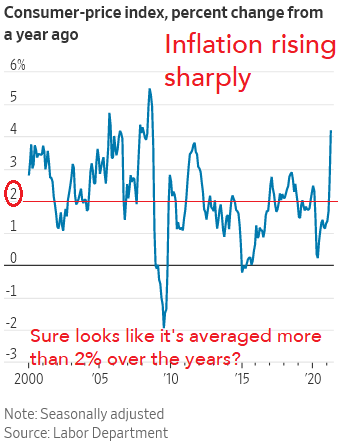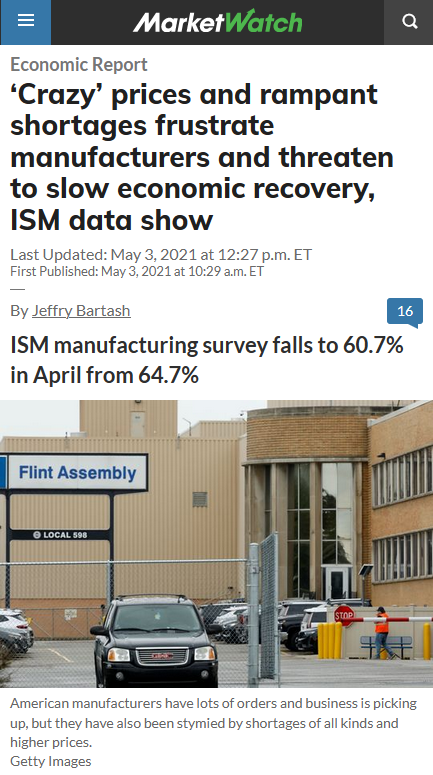Hello all – we hope you had a nice May.
Stocks closed the month not far from where they started. The Dow rose 1.9%, the S&P 500 added 0.7%, and the Nasdaq was down 1.5%.
Stocks closed the month not far from where they started. The Dow rose 1.9%, the S&P 500 added 0.7%, and the Nasdaq was down 1.5%.
The markets moved lower in the early part of the month, but the selling proved to be a good buying opportunity as stocks rebounded into the end of May.
_____
May was a fairly uneventful month for the markets without a lot of news. Mostly, it was a continuation of the themes of the last few months. The economy is rebounding as the country reopens and inflation is rising.
Actually, the inflation story was probably the big story of the month. The CPI and PPI inflation reports released this month showed inflation rising sharply.
These reports kicked off a decline in stocks, since higher inflation likely means the Fed will pull back on its stimulus. However, many Fed members took to the airwaves to declare that the Fed was not concerned about inflation and will not pull back on their stimulus any time soon. That helped stocks move higher.
The Fed has targeted 2% as their inflation goal (the latest CPI report was at 4.2%). Several Fed members stated that since inflation had been below 2% for a few years, they needed to see inflation above 2% for several years to balance it out.
Further, they believe this surge in inflation is temporary. That may be so. But even if inflation next year is 0%, we’re already at this higher price level that is squeezing average Americans.
We strongly believe the Fed is wrong with this policy. Their mandate is for stable prices, which would mean 0% inflation. Not only is 2% is an arbitrary number they derived out of thin air, but it’s also a destructive policy, particularly to middle- and lower-class Americans. Imagine 2% inflation for 10 years - you just lost 20% (plus the compounding) over that time period. How is that helpful?
This is a very dangerous policy that we don’t believe is even legal for them to pursue.
Here's a look at 20 years of inflation at the consumer level - the CPI (consumer price index). We can see the sharp rise recently, plus we can see how it’s clearly averaged more than 2% during that time.
Actually, the inflation story was probably the big story of the month. The CPI and PPI inflation reports released this month showed inflation rising sharply.
These reports kicked off a decline in stocks, since higher inflation likely means the Fed will pull back on its stimulus. However, many Fed members took to the airwaves to declare that the Fed was not concerned about inflation and will not pull back on their stimulus any time soon. That helped stocks move higher.
The Fed has targeted 2% as their inflation goal (the latest CPI report was at 4.2%). Several Fed members stated that since inflation had been below 2% for a few years, they needed to see inflation above 2% for several years to balance it out.
Further, they believe this surge in inflation is temporary. That may be so. But even if inflation next year is 0%, we’re already at this higher price level that is squeezing average Americans.
We strongly believe the Fed is wrong with this policy. Their mandate is for stable prices, which would mean 0% inflation. Not only is 2% is an arbitrary number they derived out of thin air, but it’s also a destructive policy, particularly to middle- and lower-class Americans. Imagine 2% inflation for 10 years - you just lost 20% (plus the compounding) over that time period. How is that helpful?
This is a very dangerous policy that we don’t believe is even legal for them to pursue.
Here's a look at 20 years of inflation at the consumer level - the CPI (consumer price index). We can see the sharp rise recently, plus we can see how it’s clearly averaged more than 2% during that time.
Inflation at the business level - the PPI (producer price index) - had its biggest gain since 2009.
Here’s a look at the price increases in some popular commodities over the past year:
Manufacturing companies cite these higher prices as a major headwind in their business.
One last chart on inflation shows that the public is becoming concerned about inflation as Goggle searches on the subject have increased.
_____
Switching gears to the economy, where the jobs picture continues to improve but economic data wasn’t as strong as the previous month.
The weekly employment report showed fewer people filing for unemployment.
The weekly employment report showed fewer people filing for unemployment.
There are a lot of jobs out there, but they aren’t getting filled. Last month had a record 8.1 million job openings. As the chart says, “that’s a lot.”
Small businesses continue to have a hard time filling jobs.
Last month we also saw the strength of the manufacturing and service sectors tick lower, but they both remain strong.
Retail sales were also lower, but this was more because the previous months’ measurements had been so strong and hard to sustain.
Finally, confidence surveys show confidence growing amongst small businesses, but stalling amongst consumers.
_____
Where does the market go from here?
Stocks had a nice bounce back from the sell-off earlier this month. There may be a little room to move higher, but from a shorter-term perspective, this isn’t an ideal point to put new money into the broader indexes. Individual stock selection would do better here, but there’s not a lot of attractive-looking investments out there now.
This commentary is for informational purposes and is not investment advice, an indicator of future performance, a solicitation, an offer to buy or sell, or a recommendation for any security. It should not be used as a primary basis for making investment decisions. Consider your own financial circumstances and goals carefully before investing. Past performance cannot guarantee results.
Stocks had a nice bounce back from the sell-off earlier this month. There may be a little room to move higher, but from a shorter-term perspective, this isn’t an ideal point to put new money into the broader indexes. Individual stock selection would do better here, but there’s not a lot of attractive-looking investments out there now.
This commentary is for informational purposes and is not investment advice, an indicator of future performance, a solicitation, an offer to buy or sell, or a recommendation for any security. It should not be used as a primary basis for making investment decisions. Consider your own financial circumstances and goals carefully before investing. Past performance cannot guarantee results.














